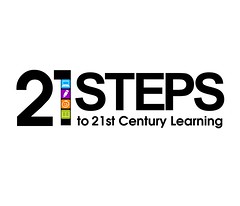 AALF is pleased to announce that it will shortly be releasing a new version of one of its most popular resources, 21 Steps to 21st Century Learning. This new edition, developed with generous sponsorship support from Microsoft, will be accompanied by a number of new resources, including a series of videos highlighting how a number of outstanding 1:1 schools from around the world are addressing different aspects of the 21 Steps. AALF is pleased to announce that it will shortly be releasing a new version of one of its most popular resources, 21 Steps to 21st Century Learning. This new edition, developed with generous sponsorship support from Microsoft, will be accompanied by a number of new resources, including a series of videos highlighting how a number of outstanding 1:1 schools from around the world are addressing different aspects of the 21 Steps.
The 21 Steps to 21st Century Learning framework is a guide for schools and school districts as they envision, plan, implement, evaluate and expand 1:1 learning in their schools. Since the first 1:1 programs began over twenty years ago, tens of thousands of schools across the globe have piloted or implemented 1:1 in their schools and school districts. Much has been written about the benefits of 1:1 and its potential to create a revolution in when, where, what, and how students learn. But to create a true learning revolution more must be done than just providing all students with their own personal computers.
In analyzing the experiences of these 1:1 initiatives, it became clear that the most successful initiatives all have one main characteristic in common: they are first and foremost concerned with learning, not laptops. Next, it became apparent that these successful initiatives followed a very similar series of steps and practices, whereas those that reported the most problems did not. These key steps and practices form the core of the 21 Steps to 21st Century Learning.
The 21 Steps to 21st Century Learning are divided into five main Phases:
Phase 1: Understanding the Compelling Case for Change
Phase 2: Redesign Learning and Teaching
Phase 3: Lead the Shift
Phase 4: Implement
Phase 5: Review. Evaluate. Grow
The new 21 Steps to 21st Century Learning will be available mid-spring, 2013. Check back here regularly for more updates!
**********************
Excerpts from the 21 Steps to 21st Century Learning videos:
Ron Canuel, CEO, Canadian Education Association and former Director General of the Eastern Township School Board, Quebec, Canada
Many people just simply felt that ‘no no no, we've always done things in a pilot project approach, so if someone’s going to get some technology, its going to be only 3 schools, or keep it narrow to a few grade levels and no more than that.’ I insisted no. If we're going to do something, it had to be systemic. We weren't going to do a pilot project.
Thuan Nguyen, Chief Information Officer, Kent School District, WA, USA
So when you look as a whole, equity is a major component because we know that there are families that can afford it and then we also know there are those that can't. From that technology vision, establishing that baseline to make sure that every student has equal access is really critical to us.
Chris Gerry, Co-Founder, the Skills Lab, UK
So trying to change a dispersed piecemeal system heavily dependent and kind of a tribal hierarchy is when one person has got to say yes, this is what we do. And they’ve got to be pretty brave to do that because it’s pretty lonely and then they’ve got to have an idea about well how do you do this in school? How would I enable these people to behave in different ways?
Charlotte Schlichtkrull, Teacher and Co-ordinator of Supplementary Teaching, Hellerup School, Denmark
I think it's very important when you teach that you share the responsibility with your colleagues because the time of one class, one book, one subject, one teacher, it’s over! …. So, it's a great thing about this school, that we work so close together and we help each other and we ask questions and we get wiser together.
Esme Capp, Principal, Princes Hill Primary School, Australia
I think the key element in terms of aligning to the curriculum development is valuing that each child is an individual. And that each child's journey will come around in a different timeframe.
|

